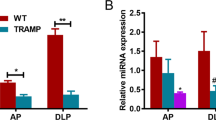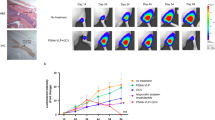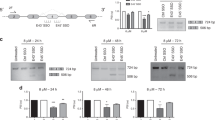Abstract
RNA interference technology is emerging as a very potent tool to obtain a cellular knockdown of a desired gene. In this work we used vector-based RNA interference to inhibit vascular endothelial growth factor (VEGF) expression in prostate cancer in vitro and in vivo. We demonstrated that transduction with a plasmid carrying a small interfering RNA targeting all isoforms of VEGF, dramatically impairs the expression of this growth factor in the human prostate cancer cell line PC3. As a consequence, PC3 cells loose their ability to induce one of the fundamental steps of angiogenesis, namely the formation of a tube-like network in vitro. Most importantly, our “therapeutic” vector is able to impair tumor growth rate and vascularization in vivo. We show that a single injection of naked plasmid in developing neoplastic mass significantly decreases microvessel density in an androgen-refractory prostate xenograft and is able to sustain a long-term slowing down of tumor growth. In conclusion, our results confirm the basic role of VEGF in the angiogenic development of prostate carcinoma, and suggest that the use of our vector-based RNA interference approach to inhibit angiogenesis could be an effective tool in view of future gene therapy applications for prostate cancer.
This is a preview of subscription content, access via your institution
Access options
Subscribe to this journal
Receive 12 print issues and online access
$259.00 per year
only $21.58 per issue
Buy this article
- Purchase on Springer Link
- Instant access to full article PDF
Prices may be subject to local taxes which are calculated during checkout




Similar content being viewed by others
References
Cookson MM . Prostate cancer: screening and early detection. Cancer Control. 2001;8:133–140.
Levi F, Lucchini F, Negri E, Boyle P, La Vecchia C . Leveling of prostate cancer mortality in Western Europe. Prostate. 2004;60:46–52.
Hegarty NJ, Fitzpatrick JM, Richie JP, et al. Future prospects in prostate cancer. Prostate. 1999;40:261–268.
Izawa JI, Dinney CP . The role of angiogenesis in prostate and other urologic cancers: a review. CMAJ. 2001;164:662–670.
Josephs IB, Isaacs JT . Angiogenesis and prostate cancer. In: Chung LWK, Isaacs WB, Simons JW, eds. Prostate Cancer: Biology, Genetics and the New Therapeutics. Totowa, NJ: Humana Press Inc.; 2000: 279–306.
Ferrara N, Gerber HP, LeCouter J . The biology of VEGF and its receptors. Nat Med. 2003;9:669–676.
Ferrer FA, Miller LJ, Andrawis RI : et al. Vascular endothelial growth factor (VEGF) expression in human prostate cancer: in situ and in vitro expression of VEGF by human prostate cancer cells. J Urol. 1997;157:2329–2333.
Jackson MW, Bentel JM, Tilley WD . Vascular endothelial growth factor (VEGF) expression in prostate cancer and benign prostatic hyperplasia. J Urol. 1997;157:2323–2328.
Shariat SF, Anwuri VA, Lamb DJ, Shah NV, Wheeler TM, Slawin KM . Association of preoperative plasma levels of vascular endothelial growth factor and soluble vascular cell adhesion molecule-1 with lymph node status and biochemical progression after radical prostatectomy. J Clin Oncol. 2004;22:1655–1663.
Huss WJ, Hanrahan CF, Barrios RJ, Simons JW, Greenberg NM . Angiogenesis and prostate cancer: identification of a molecular progression switch. Cancer Res. 2001;61:2736–2743.
Fire A, Xu S, Montgomery MK, Kostas SA, Driver SE, Mello CC . Potent and specific genetic interference by double-stranded RNA in Caenorhabditis elegans. Nature. 1998;391:806–811.
Li K, Lin SY, Brunicardi FC, Seu P . Use of RNA interference to target cyclin E-overexpressing hepatocellular carcinoma. Cancer Res. 2003;63:3593–3597.
Lakka SS, Gondi CS, Yanamandra N, et al. Inhibition of cathepsin B and MMP-9 gene expression in glioblastoma cell line via RNA interference reduces tumor cell invasion, tumor growth and angiogenesis. Oncogene. 2004;23:4681–4689.
Spankuch B, Matthess Y, Knecht R, Zimmer B, Kaufmann M, Strebhardt K . Cancer inhibition in nude mice after systemic application of U6 promoter-driven short hairpin RNAs against PLK1. J Natl Cancer Inst. 2004;96:862–872.
Takei Y, Kadomatsu K, Yuzawa Y, Matsuo S, Muramatsu T . A small interfering RNA targeting vascular endothelial growth factor as cancer therapeutics. Cancer Res. 2004;64:3365–3370.
Paul CP, Good PD, Winer I, Engelke DR . Effective expression of small interfering RNA in human cells. Nat Biotechnol. 2002;20:505–508.
Ciafrè SA, Niola F, Wannenes F, e Farace MG . An anti-VEGF ribozyme embedded within the adenoviral VAI sequence inhibits glioblastoma cell angiogenic potential in vitro. J Vasc Res. 2004;41:220–228.
Grunstein J, Masbad JJ, Hickey R, Giordano F, Johnson RS . Isoforms of vascular endothelial growth factor act in a coordinate fashion to recruit and expand tumor vasculature. Mol Cell Biol. 2000;20:7282–7291.
Yu JL, Rak JW, Klement G, Kerbel RS . Vascular endothelial growth factor isoform expression as a determinant of blood vessel patterning in human melanoma xenografts. Cancer Res. 2002;62:1838–1846.
Guo P, Xu L, Pan S, et al. Vascular endothelial growth factor isoforms display distinct activities in promoting tumor angiogenesis at different anatomic sites. Cancer Res. 2001;61:8569–8577.
Carmell MA, Hannon GJ . RNase III enzymes and the initiation of gene silencing. Nat Struct Mol Biol. 2004;11:214–218.
Rubinson DA, Dillon CP, Kwiatkowski AV, et al. A lentivirus-based system to functionally silence genes in primary mammalian cells, stem cells and transgenic mice by RNA interference. Nat Genet. 2003;33:401–406.
Gupta S, Schoer RA, Egan JE, Hannon GJ, Mittal V . Inducible, reversible, and stable RNA interference in mammalian cells. Proc Natl Acad Sci USA. 2004;101:1927–1932.
Ferrara N . Vascular endothelial growth factor: molecular and biological aspects. Curr Top Microbiol Immunol. 1999;237:1–30.
Trojan L, Thomas D, Knoll T, Grobholz R, Alken P, Michel MS . Expression of pro-angiogenic growth factors VEGF, EGF and bFGF and their topographical relation to neovascularisation in prostate cancer. Urol Res. 2003;32:97–103.
Filleur S, Courtin A, Ait-Si-Ali S, et al. SiRNA-mediated inhibition of vascular endothelial growth factor severely limits tumor resistance to antiangiogenic thrombospondin-1 and slows tumor vascularization and growth. Cancer Res. 2003;63:3919–3922.
Shi W, Siemann DW . Simultaneous targeting of VEGF message and VEGF receptor signaling as a therapeutic anticancer approach. Anticancer Res. 2004;24:213–218.
Wu H, Hait WN, Yang JM . Small interfering RNA-induced suppression of MDR1 (P-glycoprotein) restores sensitivity to multidrug-resistant cancer cells. Cancer Res. 2003;63:1515–1519.
Lapteva N, Yang AG, Sanders DE, Strube RW, Chen SY . CXCR4 knockdown by small interfering RNA abrogates breast tumor growth in vivo. Cancer Gene Ther. 2004;12:84–89.
Xu XM, Wang D, Shen Q, Chen YQ, Wang MH . RNA-mediated gene silencing of the RON receptor tyrosine kinase alters oncogenic phenotypes of human colorectal carcinoma cells. Oncogene. 2004;23:8464–8474.
Gondi CS, Lakka SS, Dinh DH, Olivero WC, Gujrati M, Rao JS . RNAi-mediated inhibition of cathepsin B and uPAR leads to decreased cell invasion, angiogenesis and tumor growth in gliomas. Oncogene. 2004;23:8486–8496.
Brummelkamp TR, Bernards R, Agami R . A system for stable expression of short interfering RNAs in mammalian cells. Science. 2002;296:550–553.
Paddison PJ, Caudy AA, Hannon GJ . Stable suppression of gene expression by RNAi in mammalian cells. Proc Natl Acad Sci USA. 2002;99:1443–1448.
Dev IK, Dornsife RE, Hopper TM, et al. Antitumor efficacy of VEGFR2 tyrosine kinase inhibitor correlates with expression of VEGF and its receptor VEGFR2 in tumor models. Br J Cancer. 2004;91:1391–1398.
Szary J, Szala S . Intra-tumoral administration of naked plasmid DNA encoding mouse endostatin inhibits renal carcinoma growth. Int J Cancer. 2001;91:835–839.
Kim SJ, Johnson M, Koterba K, Herynk MH, Uehara H, Gallick GE . Reduced c-Met expression by an adenovirus expressing a c-Met ribozyme inhibits tumorigenic growth and lymph node metastases of PC3-LN4 prostate tumor cells in an orthotopic nude mouse model. Clin Cancer Res. 2003;9:5161–5170.
Park HS, Cheon J, Cho HY, et al. In vivo characterization of a prostate-specific antigen promoter-based suicide gene therapy for the treatment of benign prostatic hyperplasia. Gene Therapy. 2003;10:1129–1134.
Bastide C, Maroc N, Bladou F, et al. Expression of a model gene in prostate cancer cells lentivirally transduced in vitro and in vivo. Prostate Cancer Prostatic Dis. 2003;6:228–234.
Yu D, Jia WW, Gleave ME, Nelson CC, Rennie PS . Prostate-tumor targeting of gene expression by lentiviral vectors containing elements of the probasin promoter. Prostate. 2004;59:370–382.
Mabjeesh NJ, Zhong H, Simons JW . Gene therapy of prostate cancer: current and future directions. Endocr Relat Cancer. 2002;9:115–139.
Hasan J, Byers R, Jayson GC . Intra-tumoral microvessel density in human solid tumors. Br J Cancer. 2002;86:1566–1577.
Abdollahi A, Lipson KE, Sckell A, et al. Combined therapy with direct and indirect angiogenesis inhibition results in enhanced antiangiogenic and antitumor effects. Cancer Res. 2003;63:8890–8898.
O'Reilly MS . The combination of antiangiogenic therapy with other modalities. Cancer J. 2002;8:S89–S99.
Abdollahi A, Lipson KE, Han X, et al. SU5416 and SU6668 attenuate the angiogenic effects of radiation-induced tumor cell growth factor production and amplify the direct anti-endothelial action of radiation in vitro. Cancer Res. 2003;63:3755–3763.
Acknowledgements
We are particularly grateful to Bina Santoro for her critical review and helpful comments. We thank Paul D Good, Engelke lab., University of Michigan Medical School, Ann Arbor, Michigan, USA, for providing us with pAVU6+27 vector. We thank T Delli Castelli and G Bonelli for excellent technical assistance. This study was funded in part by grants from the Italian Ministry of Instruction, University and Scientific Research (MIUR), FIRB and COFIN, and from the Italian Ministry of Health, to MGF and to SAC.
Author information
Authors and Affiliations
Corresponding author
Rights and permissions
About this article
Cite this article
Wannenes, F., Ciafré, S., Niola, F. et al. Vector-based RNA interference against vascular endothelial growth factor-A significantly limits vascularization and growth of prostate cancer in vivo. Cancer Gene Ther 12, 926–934 (2005). https://doi.org/10.1038/sj.cgt.7700862
Received:
Published:
Issue Date:
DOI: https://doi.org/10.1038/sj.cgt.7700862
Keywords
This article is cited by
-
Calcium carbonate nanoparticle delivering vascular endothelial growth factor-C siRNA effectively inhibits lymphangiogenesis and growth of gastric cancer in vivo
Cancer Gene Therapy (2008)
-
VEGF-specific Short Hairpin RNA–expressing Oncolytic Adenovirus Elicits Potent Inhibition of Angiogenesis and Tumor Growth
Molecular Therapy (2007)
-
RNAi-mediated knockdown of target genes: a promising strategy for pancreatic cancer research
Cancer Gene Therapy (2007)
-
Effects of shRNA targeting VEGF on VEGF mRNA expression in gastric cancer cells
Journal of Huazhong University of Science and Technology (2007)
-
RNA interference-mediated gene silencing of vascular endothelial growth factor
Chinese Journal of Clinical Oncology (2006)



